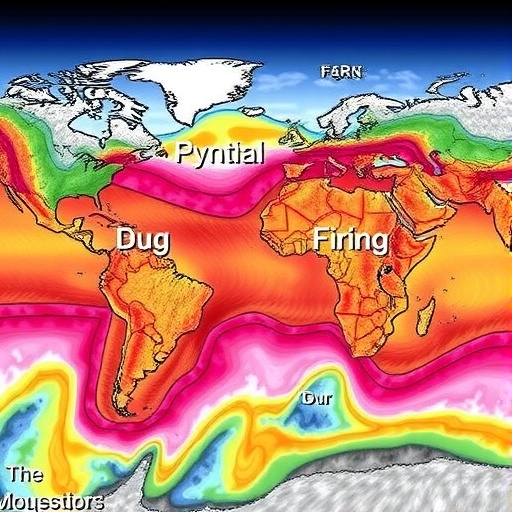In a groundbreaking study that challenges existing paradigms about Earth’s internal water dynamics, an international team of geoscientists has unveiled the enigmatic origins of seismic low-velocity zones located beneath subducting tectonic plates. Spearheaded by researchers from the Chinese Academy of Sciences’ Institute of Geology and Geophysics and the University of Padua, the collaborative effort employed cutting-edge geodynamic simulations paired with comprehensive global seismic data to reveal that these low-velocity anomalies are primarily caused by partial melts produced through the ascent of water-rich mantle material.
Seismic low-velocity zones (LVZs) have long appeared as puzzling features in the mantle, identified through their anomalously slow propagation of seismic waves. These LVZs are characterized by remarkably sharp seismic boundaries and enhanced electrical conductivity, extending from relatively shallow depths near 100 kilometers to depths approaching the 660-kilometer boundary beneath subducting slabs. Though the dehydration of descending slabs explains the occurrence of LVZs situated above tectonic plates, the existence and persistence of such zones beneath the plates have mystified scientists for decades.
Central to this discovery is the mantle transition zone (MTZ), a pivotal region of the Earth’s interior extending roughly between 410 and 660 kilometers in depth. This zone is known to act as a significant reservoir of water, storing quantities potentially equivalent to that found in the Earth’s oceans. The MTZ hosts hydrous minerals such as wadsleyite and ringwoodite, which incorporate water into their crystal structures. The study reveals that as subducting slabs penetrate into the mantle, they mechanically interact with these water-laden minerals, effectively “scraping” and entraining hydrated mantle material upwards.
This upwelling water-rich mantle material experiences decreasing pressure as it ascends, triggering dehydration melting processes. This produces partial melts characterized by melt fractions typically ranging between one and three percent by volume. These melts are critical because they sufficiently reduce seismic wave speeds and increase electrical conductivity within the LVZs, directly accounting for the observed geophysical signatures. Crucially, for this mechanism to operate at scale, the MTZ must contain more than 0.2% water over regions exceeding 120 kilometers in lateral dimensions, a condition corroborated by evidence from diamond inclusions and electromagnetic geophysical surveys.
The patterns of melt accumulation beneath tectonic plates resemble a planetary-scale conveyor belt system. These melt accumulations are sheared and thinned into layers approximately 10 to 25 kilometers thick, which are then dragged back into the MTZ by the continuing subduction of tectonic slabs. This cyclical water recycling loop not only redistributes mantle fluids but also engenders profound effects on mantle rheology, notably by reducing viscosity in the affected regions. This lubrication effect facilitates plate tectonic motions and promotes chemical exchanges between different layers within the Earth’s interior.
Beyond their fundamental geophysical significance, these findings offer a cohesive explanation for the global occurrence of LVZs, including those beneath the vast Pacific subduction zones and complex continental collision belts such as the Alps. The process described reframes our understanding of subduction zones, shifting the perspective from seeing them merely as sites of tectonic plate destruction to recognizing them as dynamic and integral components of Earth’s deep-water recycling mechanism.
The incorporation of advanced computational models with observational seismic data represents a significant methodological advance, enabling precise quantification of melt volumes and water content in the deep mantle. These models simulate the intricate interactions between mechanical subduction forces and chemical-hydrological processes within the MTZ, offering unprecedented insights into the coupling between mantle dynamics and surface tectonics.
This research also holds far-reaching implications for understanding seismic hazards. Since the presence of partial melts influences mantle viscosity and stress distributions, it potentially affects the generation and propagation of earthquakes along subduction interfaces. Future investigations aim to integrate joint seismic-electromagnetic surveys to map water distribution more accurately within the MTZ worldwide and to analyze how melt-mediated changes in mantle rheology may impact seismicity patterns.
Furthermore, this study’s revelation of hydraulic pathways and melt generation depths enhances our broader comprehension of the deep Earth’s water cycle, which plays a crucial role in planetary evolution and habitability. The feedback mechanisms between surface water reservoirs, mantle hydration, and tectonic recycling emerge as vital processes sustaining Earth’s geodynamic and geochemical equilibrium.
According to Prof. Liang Zhao, co-corresponding author, the unexpectedly deep persistence of LVZs “points unambiguously to a source of melting residing far deeper than previously conceived,” substantiating the vital role of the transition zone’s hydrous environment in global mantle dynamics. Co-corresponding author Prof. Manuele Faccenda eloquently summarized the paradigm shift: “Subduction isn’t just a graveyard for plates; it’s a recycling plant for Earth’s deep water,” emphasizing the profound systemic nature of these processes.
In conclusion, the synthesis of seismic observation and computational modeling presented in this study not only solves a longstanding geological puzzle but also opens new avenues for multidisciplinary exploration of Earth’s deep interior. As the scientific community continues to refine techniques and amalgamate diverse datasets, our understanding of the deep-water cycle and its tectonic implications will grow, offering transformative knowledge about the dynamic planet we inhabit.
Subject of Research: Geodynamics and mantle water cycling beneath subducting tectonic plates
Article Title: Partial Melts from Water-Rich Mantle Material Explain Seismic Low-Velocity Zones Beneath Subducting Plates
Web References: 10.1093/nsr/nwaf314
References: Information derived from geodynamic simulations and global seismic and electromagnetic observations as reported in National Science Review
Keywords: Mantle transition zone, low-velocity zones, partial melt, subduction, dehydration melting, geodynamics, mantle water cycle, seismic anomalies, mantle viscosity, water-rich minerals, wadsleyite, ringwoodite




